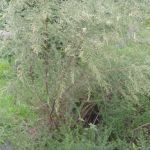| Common Name: |
Fragrant Wormwood |
| Botanical Name: |
Artemisia capillaris |
| Genus: |
Artemisia |
| Family: |
Asteraceae |
| Native Location: |
China, Korea, Japan and Phillipines |
| Cultivation: |
Well-drained, neutral to slightly alkaline soil in sun. Artemisia absinthium, A. a. 'Lambrook Silver', and A. lucoviciana tolerate drought. A. capillaris thrives in moist soil and tolerates light shade. Hardiness varies with species; cover marginally hardy plants with loose straw or overwinter plants under cover. In spring, cut back shrubby species near ground level, or remove dead stems and trim to shape. Rust may attack foliage. |
| Propagation: |
By seed sown in spring (annuals, perennials, and A. d. subsp. dracunculoides); by semi-ripe cuttings with a heel in summer (shrubby species); by division in autumn or spring (perennials). |
| Harvest: |
By seed sown in spring (annuals, perennials, and A. d. subsp. dracunculoides); by semi-ripe cuttings with a heel in summer (shrubby species); by division in autumn or spring (perennials). |
| Height: |
30cm-1m (1-3ft) |
| Width: |
30cm-1m (1-3ft) |
| Hardiness: |
Z5-8 |
| Parts Used: |
Leaves, young shoots (yin chen hao, Herba Artemisiae) |
| Properties: |
A bitter, aromatic, diuretic herb that acts as a tonic for the liver and gall bladder, and lowers fever. |
| Medicinal Uses: |
Internally for feverish illnesses, jaundice, hepatitis, and gall bladder complaints. |
| Warning: |
Artemisias, and extracts from them, such as cineole and santonin, are subject to legal restrictions in some countries. |
| Bibliography: |
Encylopedia of Herbs by Deni Brown Copyright ©: 1995, 2001 Dorling Kindersley Limited pp 130-132
|

